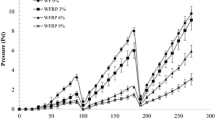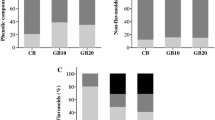Abstract
The effect of selected plant additives (couch grass, artichoke, kale, nettle, ground buckwheat husks, broad beans, fenugreek seeds, and extracts of yellow tea and mulberry leaf) on the volatile compounds, color, texture, sensory attributes, polyphenols, and antioxidant properties of triticale crisp bread was studied. The volatile profile of control bread was dominated by lipid oxidation products with hexanal and (E)-2-nonenal predominant. The additives strongly modified the volatile profile of the extruded crisp bread. The greatest differences were recorded in the case of products with artichoke and kale additions, which had respectively about 12 and 8 times higher levels of total volatile compounds than the control crisp bread. The samples containing kale, buckwheat, and fenugreek as well as yellow tea extract characterized high levels of sulfur compounds, with methanethiol predominant. The additives, especially kale, nettle, and artichoke affected the color of the crisp breads, in most cases making them darker. In terms of texture only the crisp bread with addition of buckwheat husk was significantly harder than the control sample. On the basis of sensory evaluation it was stated that among all the additives, the artichoke and fenugreek resulted in dramatic deterioration in the extruded product taste. The used additives also affected the antioxidant properties of triticale crisp bread. The greatest content of total phenolic compounds and the highest antioxidant activity were observed for the bread with yellow tea extract addition (3.5- and 6.5-fold higher, respectively, than in control sample).



Similar content being viewed by others
References
Altan A, Maskan M (2011) Development of extruded foods by utilizing food industry by-products. In: Maskan M, Altan A (eds) Advances in food extrusion technology. CRC Pres, Boca Raton, pp 121–167
Andallu B, Mahalakshmi S, Rajeshwari CU, Shobha RI (2014) In vitro free radical scavenging and in vivo antioxidant potential of mulberry (Morus indica L.) leaves. J Herbal Med 4:10–17
Anton AA, Fulcher RG, Arntfield SD (2009) Physical and nutritional impact of fortification of corn starch-based extruded snacks with common bean (Phaseolus vulgaris L.) flour: effects of bean addition and extrusion cooking. Food Chem 113:989–996
Arêas JAG, Rocha-Olivieri CM, Marques MR (2016) Extrusion cooking: chemical and nutritional changes. Encyclopedia of food and health. Academic Press, Oxford, pp 569–575
Belitz H-D, Grosch W, Schieberle P (2004) Food chemistry. Springer, Berlin
Brennan C, Brennan M, Derbyshire E, Tiwari BK (2011) Effects of extrusion on the polyphenols, vitamins and antioxidant activity of foods. Trends Food Sci Technol 22:570–575
Dufresne CJ, Farnworth ER (2001) A review of latest research findings on the health promotion properties of tea. J Nutr Biochem 12:404–421
Dziki D, Różyło R, Gawlik-Dziki U, Świeca M (2014) Current trends in the enhancement of antioxidant activity of wheat bread by the addition of plant materials rich in phenolic compounds. Trends Food Sci Technol 40:48–61
Gamlath S, Ravindran G (2009) Extruded products with Fenugreek (Trigonella foenum-graecium) chickpea and rice: physical properties, sensory acceptability and glycaemic index. J Food Eng 90:44–52
Grosch W (1987) Reactions of hydroperoxidess products of low molecular weight. In: Chan HW-S (ed) Autooxidation of unsaturated lipids. Academic Press, London, pp 95–139
Gumienna M, Goderska K, Nowak J, Czarnecki Z (2006) Changes in the antioxidative activities of bean products and intestinal microflora in the model of the gastrointestinal tract “in vitro”. PJFNS 15:29–32
Gürocak S, Küpeli B (2006) Consumption of historical and current phytotherapeutic agents for urolithiasis: a critical review. J Urol 176:450–455
Hansen A, Schieberle P (2005) Generation of aroma compounds during sourdough fermentation: applied and fundamental aspects. Trends Food Sci Technol 16:85–94
Hein KA, Jaeger SR, Carr BT, Delahunty CM (2008) Comparison of five common acceptance and preference methods. Food Qual Pref 19:651–661
Heydanek MG, McGorrin RJ (1981) Gas chromatography-mass spectroscopy identification of volatiles from rancid oat groats. J Agric Food Chem 29:1093–1095
Ho CT, Riha Iii WE (2005) Formation of Maillard aromas during extrusion cooking. In: O’Brien J, Nursten HE, James M, Crabbe C, Ames JM (eds) The Maillard reaction in foods and medicine. Woodhead Publishing Limited, Cambrigde, pp 187–192
Hooda S, Jood S (2005) Organoleptic and nutritional evaluation of wheat biscuits supplemented with untreated and treated fenugreek flour. Food Chem 90:427–435
Johnson TA, Sohn JS, Inman WD, Bjeldanes LF, Rayburn K (2013) Lipophilic stinging nettle extracts possess potent anti-inflammatory activity, are not cytotoxic and may be superior to traditional tinctures for treating inflammatory disorders. Phytomedicine 20:143–147
Korus A, Lisiewska Z (2011) Effect of preliminary processing and method of preservation on the content of selected antioxidative compounds in kale (Brassica oleracea L. var. acephala) leaves. Food Chem 129:149–154
Krkoskova B, Mrazova Z (2005) Prophylactic components of buckwheat. Food Res Int 38:561–568
Kumar RP, Sujatha D, Saleem TSM, Chetty CM, Ranganayakulu D (2010) Potential antidiabetic and antioxidant activities of Morus indica and Asystasia gangetica in alloxan-induced diabetes mellitus. J Exp Pharmacol 2:29–36
Lattanzio V, Kroon PA, Linsalata V, Cardinali A (2009) Globe artichoke: a functional food and source of nutraceutical ingredients. J Funct Foods 1:131–144
Majcher M, Jeleń HH (2007) Effect of cysteine and cystine addition on sensory profile and potent odorants of extruded potato snacks. J Agric Food Chem 55:5754–5760
Mauron J (1981) The Maillard reaction in food: a critical review from the nutritional standpoint. Prog Food Nutr Sci 5:5–35
Menin B, Comino C, Portis E, Moglia A, Cankar K, Bouwmeester H, Lanteri S, Beekwilder J (2012) Genetic mapping characterization of the globe artichoke (+)-germacrene A synthase gene, encoding the first dedicated enzyme for biosynthesis of the bitter sesquiterpene lactone cynaropicrin. Plant Sci 190:1–8
Mokrzycki WS, Tatol M (2011) Color difference ΔE: a survey. Mach Gr Vis 20:383–411
Naidu MM, Shyamala BN, Naik PJ, Sulochanamma G, Srinivas P (2011) Chemical composition and antioxidant activity of the husk and endosperm of fenugreek seeds. LWT Food Sci Technol 44:451–456
Peres F, Jeleń HH, Majcher MM, Arraias M, Martins LL, Ferreira-Dias S (2013) Characterization of aroma compounds in Portuguese extra virgin olive oils from Galega Vulgar and Cobrançosa cultivars using GC–O and GC × GC–ToFMS. Food Res Int 54:1979–1986
Re R, Pellegrini N, Proteggente A, Pannaqla A, Yang M, Rice-Evans C (1999) Antioxidant activity applying in improved ABTS radical cation decolorization assay. Free Radical Bio Med 26:1231–1237
Robin F, Dubois C, Curti D, Schuchmann HP, Palzer S (2011) Effect of wheat bran on the mechanical properties of extruded starchy foams. Food Res Int 44:2880–2888
Sharma P, Gujral HS, Singh B (2012) Antioxidant activity of barley as affected by extrusion cooking. Food Chem 131:1406–1413
Singleton VL, Rossi JA (1965) Colorimetry of total phenolics with phosphomolybdic- phosphotungstic acid reagents. Am J Enol Vitic 16:144–158
Stojceska V, Ainsworth P, Plunkett A, Ibanoglu E, Ibanoglu S (2008) Cauliflower by-products as a new source of dietary fiber, antioxidants and proteins in cereal based ready-to-eat expanded snacks. J Food Eng 87:554–563
Stojceska V, Ainsworth P, Plunkett A, İbanoğlu S (2009) The effect of extrusion cooking using different water feed rates on the quality of ready-to-eat snacks made from food by-products. Food Chem 114:226–232
Zhan-Lu Z, Mei-Liang Z, Yu T, Fa-Liang L, Yi-Xiong T, Ji-Rong S, Wen-Tong X et al (2012) Bioactive compounds in functional buckwheat food. Food Res Int 49:389–395
Acknowledgements
This research was financially supported by EU Project No. POIG 01.01.02-00-061/09.
Author information
Authors and Affiliations
Corresponding author
Rights and permissions
About this article
Cite this article
Makowska, A., Majcher, M., Mildner-Szkudlarz, S. et al. Triticale crisp bread enriched with selected bioactive additives: volatile profile, physical characteristics, sensory and nutritional properties. J Food Sci Technol 54, 3092–3101 (2017). https://doi.org/10.1007/s13197-017-2745-y
Revised:
Accepted:
Published:
Issue Date:
DOI: https://doi.org/10.1007/s13197-017-2745-y




